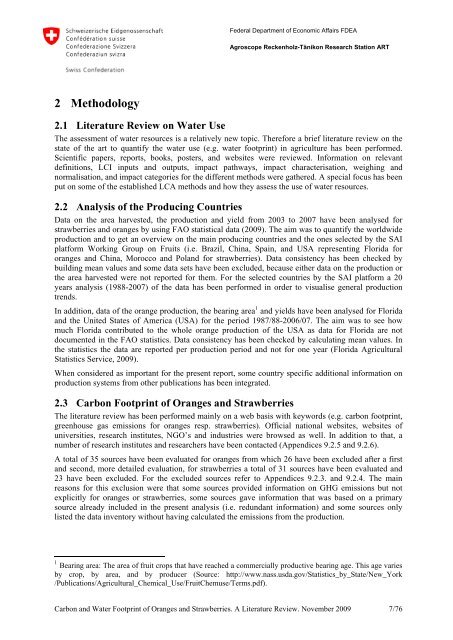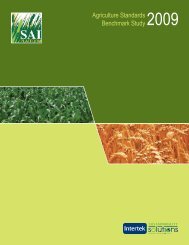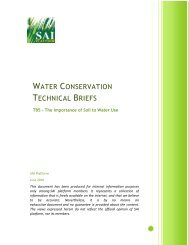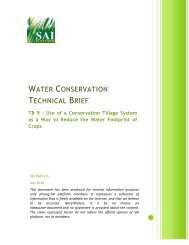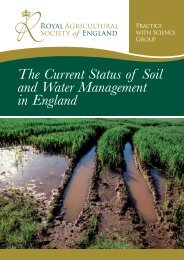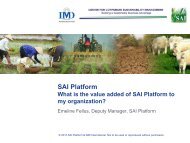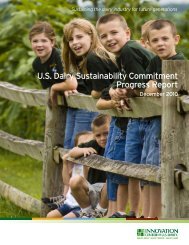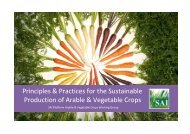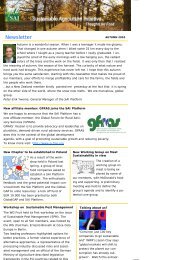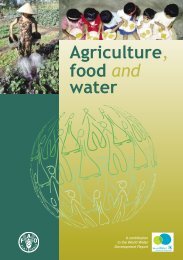Carbon & Water Footprint of Oranges and Strawberries - SAI Platform
Carbon & Water Footprint of Oranges and Strawberries - SAI Platform
Carbon & Water Footprint of Oranges and Strawberries - SAI Platform
You also want an ePaper? Increase the reach of your titles
YUMPU automatically turns print PDFs into web optimized ePapers that Google loves.
Federal Department <strong>of</strong> Economic Affairs FDEA<br />
Agroscope Reckenholz-Tänikon Research Station AR T<br />
2 Methodology<br />
2.1 Literature Review on <strong>Water</strong> Use<br />
The assessment <strong>of</strong> water resources is a relatively new topic. Therefore a brief literature review on the<br />
state <strong>of</strong> the art to quantify the water use (e.g. water footprint) in agriculture has been performed.<br />
Scientific papers, reports, books, posters, <strong>and</strong> websites were reviewed. Information on relevant<br />
definitions, LCI inputs <strong>and</strong> outputs, impact pathways, impact characterisation, weighing <strong>and</strong><br />
normalisation, <strong>and</strong> impact categories for the different methods were gathered. A special focus has been<br />
put on some <strong>of</strong> the established LCA methods <strong>and</strong> how they assess the use <strong>of</strong> water resources.<br />
2.2 Analysis <strong>of</strong> the Producing Countries<br />
Data on the area harvested, the production <strong>and</strong> yield from 2003 to 2007 have been analysed for<br />
strawberries <strong>and</strong> oranges by using FAO statistical data (2009). The aim was to quantify the worldwide<br />
production <strong>and</strong> to get an overview on the main producing countries <strong>and</strong> the ones selected by the <strong>SAI</strong><br />
platform Working Group on Fruits (i.e. Brazil, China, Spain, <strong>and</strong> USA representing Florida for<br />
oranges <strong>and</strong> China, Morocco <strong>and</strong> Pol<strong>and</strong> for strawberries). Data consistency has been checked by<br />
building mean values <strong>and</strong> some data sets have been excluded, because either data on the production or<br />
the area harvested were not reported for them. For the selected countries by the <strong>SAI</strong> platform a 20<br />
years analysis (1988-2007) <strong>of</strong> the data has been performed in order to visualise general production<br />
trends.<br />
In addition, data <strong>of</strong> the orange production, the bearing area 1 <strong>and</strong> yields have been analysed for Florida<br />
<strong>and</strong> the United States <strong>of</strong> America (USA) for the period 1987/88-2006/07. The aim was to see how<br />
much Florida contributed to the whole orange production <strong>of</strong> the USA as data for Florida are not<br />
documented in the FAO statistics. Data consistency has been checked by calculating mean values. In<br />
the statistics the data are reported per production period <strong>and</strong> not for one year (Florida Agricultural<br />
Statistics Service, 2009).<br />
When considered as important for the present report, some country specific additional information on<br />
production systems from other publications has been integrated.<br />
2.3 <strong>Carbon</strong> <strong>Footprint</strong> <strong>of</strong> <strong>Oranges</strong> <strong>and</strong> <strong>Strawberries</strong><br />
The literature review has been performed mainly on a web basis with keywords (e.g. carbon footprint,<br />
greenhouse gas emissions for oranges resp. strawberries). Official national websites, websites <strong>of</strong><br />
universities, research institutes, NGO’s <strong>and</strong> industries were browsed as well. In addition to that, a<br />
number <strong>of</strong> research institutes <strong>and</strong> researchers have been contacted (Appendices 9.2.5 <strong>and</strong> 9.2.6).<br />
A total <strong>of</strong> 35 sources have been evaluated for oranges from which 26 have been excluded after a first<br />
<strong>and</strong> second, more detailed evaluation, for strawberries a total <strong>of</strong> 31 sources have been evaluated <strong>and</strong><br />
23 have been excluded. For the excluded sources refer to Appendices 9.2.3. <strong>and</strong> 9.2.4. The main<br />
reasons for this exclusion were that some sources provided information on GHG emissions but not<br />
explicitly for oranges or strawberries, some sources gave information that was based on a primary<br />
source already included in the present analysis (i.e. redundant information) <strong>and</strong> some sources only<br />
listed the data inventory without having calculated the emissions from the production.<br />
1 Bearing area: The area <strong>of</strong> fruit crops that have reached a commercially productive bearing age. This age varies<br />
by crop, by area, <strong>and</strong> by producer (Source: http://www.nass.usda.gov/Statistics_by_State/New_York<br />
/Publications/Agricultural_Chemical_Use/FruitChemuse/Terms.pdf).<br />
<strong>Carbon</strong> <strong>and</strong> <strong>Water</strong> <strong>Footprint</strong> <strong>of</strong> <strong>Oranges</strong> <strong>and</strong> <strong>Strawberries</strong>. A Literature Review. November 2009 7/76


